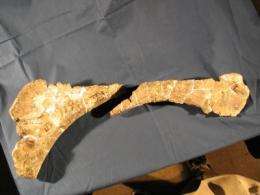Crushed bones reveal literal dino stomping ground

Imagine the gruesome sound of bones snapping as a thirsty, 30-ton dinosaur tramples a heap of fresh carcasses on his way to a rapidly shrinking lake.
That's the scene revealed by a painstaking analysis of thousands of bones unearthed near Moab, Utah by geologists from Brigham Young University.
So far the researchers have identified 67 individual dinosaurs representing 8 species - and they have only scratched the surface of this diverse quarry. Mysteriously, nearly all of the 4,200 bones recovered so far are fractured, as reported in the scientific journal Palaeo.
"Although enough bones were recovered to assemble several complete dinosaurs, the vast majority of bones are broken to bits and pieces, just pulverized," said BYU professor Brooks Britt, lead author on the study.
The researchers reconstructed how the bones got there and why they are in such bad shape.
The quarry, located immediately west of Arches National Park, contains dinosaurs of all sizes and ages, indicating a massive die-off event. The location of this dense cluster of bones - near the shore of an ancient lake bed - suggests a drought was the cause.
Yet the biggest puzzle was the cause of all the fractures. A closer look revealed that most of the breaks were angled "greenstick" fractures that occur in fresh bones.
The bones broke before they became brittle.
"Some of these bones were almost 5 feet long, and they are green, and you really have to work hard to shatter bone that's still green," Britt said. "That means the big boys were stepping on those things. Those would have been audible, big snaps."
The heavy-footed culprits? Huge, plant-eating sauropods and iguanodontids that stomped more than 100 million years ago during the Early Cretaceous Period. Some of the sauropods from this quarry are cousins to the brachiosaurus.
The bones are now housed in BYU's Earth Science Museum, which will re-emerge as the Museum of Paleontology during Homecoming weekend.
Museum curator Rod Scheetz, a co-author on the study, says the grand re-opening will include the debut of a 9-foot-long triceratops skull from Montana.
Source: Brigham Young University (news : web)
















